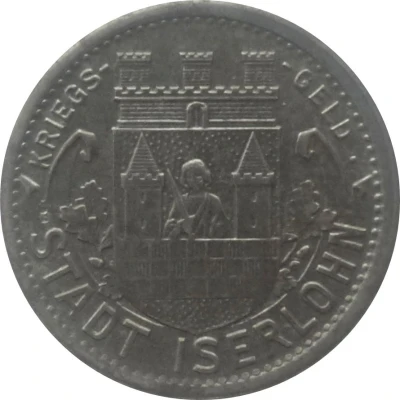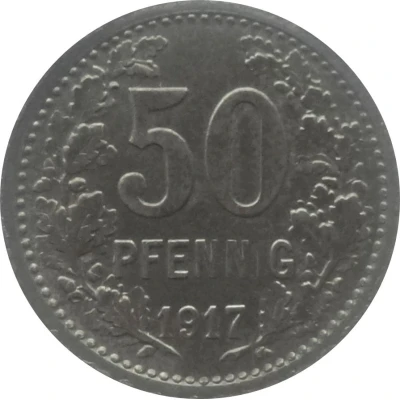


© Willem63 (CC BY-NC-SA)
50 Pfennigs - Iserlohn
1917 year| Iron | 4.52 g | 23.05 mm |
| Issuer | City of Iserlohn (Prussian province of Westphalia) |
|---|---|
| Emperor | William II (Wilhelm II) (1888-1918) |
| Type | Standard circulation coin |
| Year | 1917 |
| Value | 50 Pfennigs (50 Pfennige) (0.50) |
| Currency | Mark (1914-1924) |
| Composition | Iron |
| Weight | 4.52 g |
| Diameter | 23.05 mm |
| Thickness | 1.6 mm |
| Shape | Round |
| Technique | Milled |
| Orientation | Medal alignment ↑↑ |
| Demonetized | Yes |
| Updated | 2024-10-04 |
| Numista | N#64681 |
|---|---|
| Rarity index | 57% |
Reverse
Pearl rim surrounding oak wreath with denomination and date centered
Script: Latin
Lettering:
50
PFENNIG
1917
Edge
Plain
Comment
Issuing agency: [Stadt, Westfalen].Interesting fact
One interesting fact about the 50 Pfennigs - Iserlohn 1917 coin is that it was issued during a time of economic turmoil in Germany. The country was facing severe inflation, and the value of the German mark had dropped significantly. In response, the government introduced a new currency, the "Notgeld," which included coins like the 50 Pfennigs - Iserlohn 1917. These coins were made of iron, which was a cheaper alternative to traditional metals like silver or gold, and were designed to be used as small change. Despite their humble origins, these coins have become sought-after collectibles among numismatists today.
Price
| Date | Mintage | VG | F | VF | XF | AU | UNC |
|---|---|---|---|---|---|---|---|
| 1917 | - | - | - | - | - | - |
Values in the table are based on evaluations by sales realized on Internet platforms. They serve as an indication only for 50 Pfennigs - Iserlohn 1917 coin.